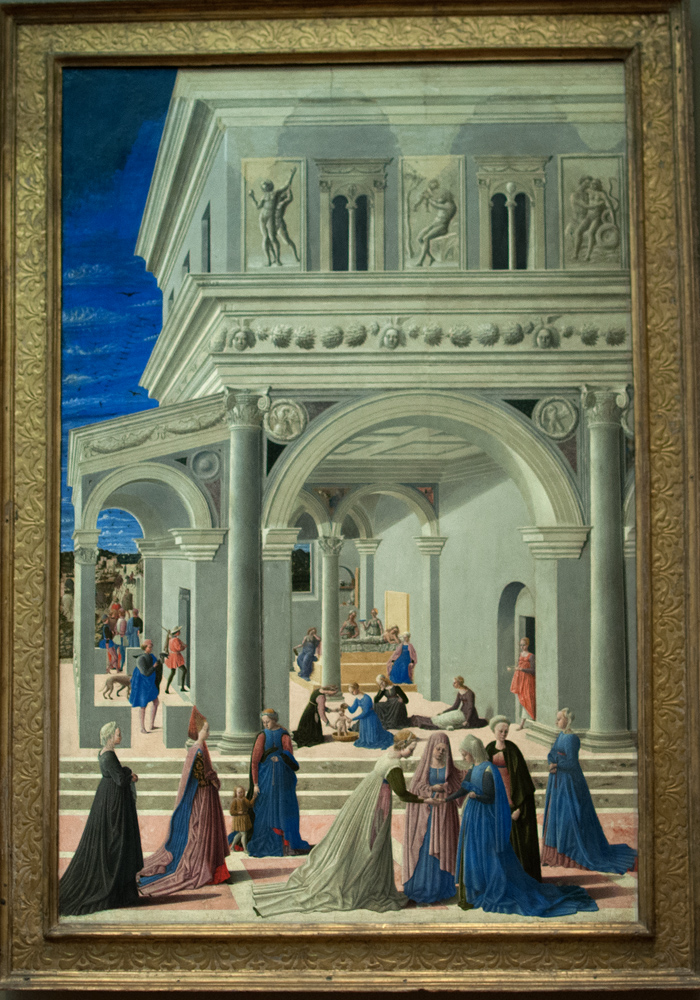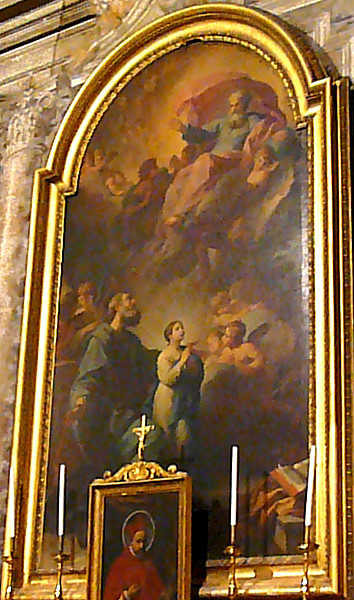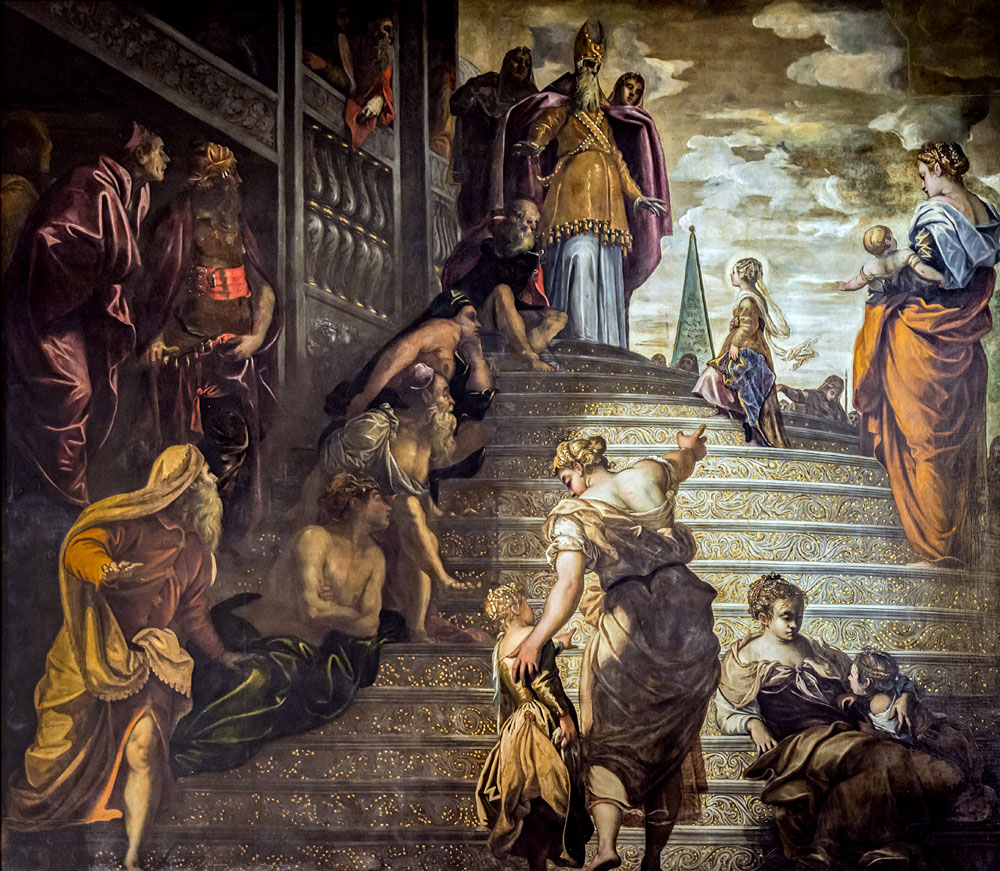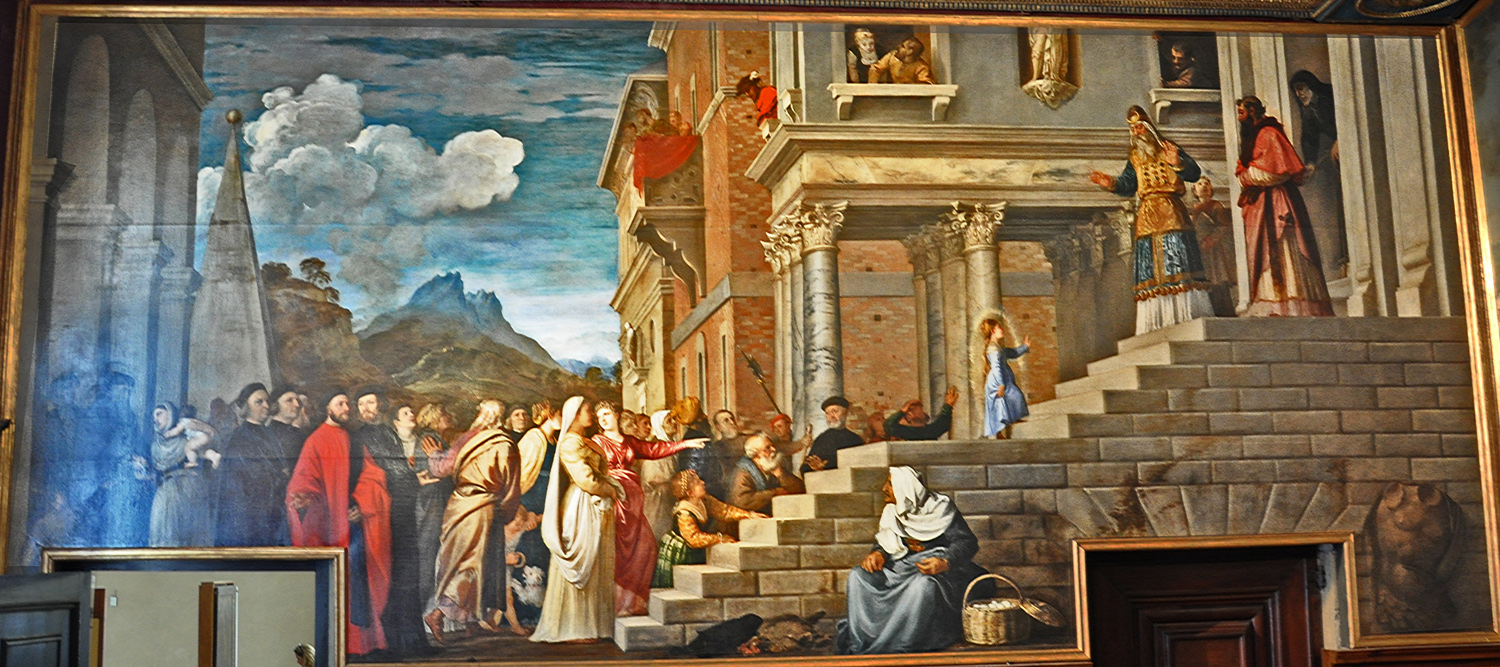PART ONE: BIRTH, YOUTH, MARRIAGE
But a number of features keep the two Nativities fairly easy to distinguish from one another. First, Mary is born in a real bed in a structure that is emphatically a private home rather than a stable or cave (example). In the Gospel of Pseudo-Matthew Joachim is a shepherd who gives most of his produce to the poor and the godly, with the result that "the Lord multiplied to him his herds, so that there was no man like him in the people of Israel." In the images his wealth is often expressed by sumptuous surroundings and serving maids. In the 17th and 18th centuries the number of servants and others in attendance swells to a veritable mob (example).
Food is another difference. Only in the Birth of Mary images does one find servants bringing the new mother something to eat: a bowl of soup in Dipre's painting (before 1531), a whole chicken in Nebbia's façade at Orvieto Cathedral (1350-90), and in the apse mosaic at Santa Maria in Trastevere (1291) a huge spread with a chicken, a jug of wine, flatbread, fruit slices, and a knife. In Pietro da Cortona's version1 a young serving girl proffers a basket of eggs, an appropriate symbol of fecundity for a woman heretofore barren.
Beginning in the Renaissance, some images place Anne farther into the background and put the baby into the arms of a youthful and vigorous attendant (example). Pietro Mara's 1635 version not only puts Anne remarkably far in the background but renders her alone in grisaille (Petricioli, 121). In some cases in the 17th and 18th centuries the attendant is a young wet nurse rather than the traditional midwife, as in this example from 1674.
Some 16th- and 17th-century images include St. Joachim as an incidental figure. In the 18th, with a greater emphasis on domesticity, he becomes more important. In this fresco, for example, he stands solidly behind mother and child, in the manner of 20th-century family portraits. And in this homely image, he sits beside the bed in the foreground, Anne holds the child, and instead of midwives we see servants warming the bedclothes.
THE PRESENTATION OF THE VIRGIN IN THE TEMPLE
The Golden Legend draws on narratives going back to the 2nd-century Protevangelium of James for this story. When Mary reaches the age of three her parents give her in service to the Temple. This seems an echo of the prophet Samuel's being given to the Temple by his mother Hannah, who like Anne bore the child after a long period of barrenness and whose grateful canticle in I Samuel 2:1-10 is reprised in Mary's "Magnificat," Luke 1:46-55. ("Anne" or "Anna" is simply a form for western languages of the Hebrew "Hannah.")The Eastern churches have observed a feast day commemorating Mary's presentation from the sixth century until the present time. Orthodox images of the event may include a procession of virgins headed by Mary (Cartlidge and Elliott, 31, 37). In the West a feast of the Virgin's presentation was in the universal calendar only from 1476 until the reforms of the Council of Trent. Consequently, images of the event are less common in the West than images of other milestones in Mary's life (Hood, 128).
The images are easy enough to identify. The child is made to look somewhat older than three and is always ascending a flight of stairs to the Temple, sometimes with her arms crossed in a gesture of humility (example). Her parents stand at the foot of the stairs, and the High Priest stands at the top. The priest may be arrayed like Aaron in a breastplate and hornlike "holy crown," as in this example and the painting shown above. But sometimes he will be made to look more like a bishop and the Temple more like a Christian church with a tabernacle (example). This reflects the tradition that Mary is the antitype of the Ark of the Covenant. As Gregory Thaumaturgus put it in the 3rd century, "the holy Virgin is in truth an ark, wrought with gold both within and without."
In the literary sources it is important that the number of steps in the stairway be fifteen, the same as the number of the "Gradual Psalms." But the artists hardly ever follow this cue. Even in the large canvas shown above it seems just too difficult to squeeze in all fifteen. (Nicolas Dipres, however, solved the problem by arranging the seven lowest steps in a circle.) Though not consistent with the claim that Mary entered Temple service at age 3, an iconography developed from at least the 14th century of sentimental domestic scenes in which St. Anne teaches Mary to read. In these Mary usually appears to be a child of anywhere from eight to fifteen years old. See my page on St. Anne. As the story continues, the Virgin Mary reaches marriageable age and the high priest prays for a sign to tell him who, if anyone, should be chosen as her spouse. In response, an angel comes and tells him to put out a call to unmarried men to bring their staffs to the Temple. God will then reveal whom he has chosen. The priest gathers the staffs, puts them on the altar, and prays over them. Then a dove appears on the tip of Joseph's staff, indicating that he is the one.2
Giotto's Scrovegni Chapel frescos include a sequence on these events. In the first the men bring their staffs to the Temple. In the second priests pray in the Temple while the men wait outside. In the third, where Joseph and Mary are betrothed, the dove sits atop Joseph's staff and a flower grows from the tip. The flower accords with the Golden Legend (#131) and The Gospel of the Nativity of Mary (§ 7), which cite the prophecy that "there shall come forth a rod out of the root of Jesse, and a flower shall rise up out of his root. And the spirit of the Lord shall rest upon him" (Isaiah 11:1-2).
The literary sources pass quickly over what one of them calls "the usual ceremonies of betrothal," but in the art the marriage rite is a common subject. Joseph is usually pictured holding his flowering staff, with a dove as in Giotto's fresco or with the flower alone as in this Ghirlandaio. There may or may not be a ring. The high priest is sometimes dressed in the artist's idea of what such an official would have worn in Mary's time (example), and sometimes as if he were a medieval bishop (example). In most images the witnesses to the ceremony are numerous (example). The Gospel of Nicodemus (II, 4) names twelve, although I have not seen any with exactly that number.
After the betrothal but before the marriage came the question of Mary's pregnancy. In both the Protevangelium of James (chapter 16) and the Gospel of Pseudo-Matthew (chapter 12) the couple are summoned to explain themselves to the high priest, who is incredulous and orders them to drink "the water of drinking of the Lord," which supposedly would cause a sign to appear on their faces if they were lying. No such sign appears, so they are exonerated. This episode is illustrated in a 6th century ivory in the Louvre.
Prepared in 2014 by Richard Stracke, Emeritus Professor of English, Augusta University.
NEXT:
PART TWO, THE ANNUNCIATION
ALSO SEE PARTS:
2
3
4
5
6
7
8
HOME PAGE
Titian, The Presentation of the Virgin Mary in the Temple, 1534-38. See the description page for a discussion of this painting.
OTHER IMAGES

In Carnevale's Birth of the Virgin the event goes unnoticed by the bystanders in the foreground and the travelers and merchants in the background. – See the description page.

Stefano Pozzi's The Virgin Presented to God the Father by St. Joachim reimagines the Presentation event symbolically. (See the description page.)

Tintoretto's Presentation influenced a number of later versions. See the description page for details.
MORE IMAGES: BIRTH OF MARY
- 1303-1305: In Giotto's fresco the central element is Anne's accepting the already bathed and swaddled baby.
- 1344: Detail from Guariento di Arpo's Coronation of the Virgin altarpiece.
- Circa 1373: Gherarducci's Initial G with the Birth of the Virgin.
- 1474: Bartolomeo Vivarini, The Birth of Mary.
- Circa 1480: Sculpture picturing only Anne and the baby lying peacefully.
- 1485-90: The Presentation and The Betrothal appear in the third register of Ghirlandaio's monumental Life of the Virgin. The birth is in the fourth register.
- 16th century: In Siciolante's Nativity of the Virgin clothing and color pair a weakened Anne with the sturdy young servant who holds the baby.
- 1547: Balduque's altarpiece at Cáceres Cathedral replaces the basin with a cradle.
- 1591-1603: Palma il Giovane, The Birth of Mary.
- 16th/17th century: Antonio Zanchi's Birth of Mary, Mother of God is another example of foregrounding a young and vigorous midwife.
- 17th century: Brandi's Birth of the Virgin Mary with Emerentia.
- 1627: Zurbarán's Birth of the Virgin uses a basket of eggs to reference Mary's perpetual virginity.
- 1696-98: Luca Giordano's Birth of the Virgin uses lighting to emphasize the special status of the child.
- 1748: In Duque Cornejo's choir stall St. Joachim stands in the birthing room directing the midwives.
- 1807-13: This archaizing sculpture of Mary's birth combines neoclassical style and medieval narrative structure.
- Undated: A painting of Mary's birth in the Basilica of Sant'Eustorgio, Milan.
MORE IMAGES: OTHER
- 1303-1305: Giotto's fresco of the Presentation includes what seem to be members of the child's family.
- 1325-70: The Life of Mary Window in Regensburg Cathedral.
- 1344: Detail from Guariento di Arpo's Coronation of the Virgin altarpiece.
- 1538-43: A Marriage of the Virgin attributed to Giampietro Silvio and (incorrectly, if the dates are right) Domenico Tintoretto.
- 1552-53: The composition of Tintoretto's Presentation of the Virgin Mary in the Temple draws the viewer into the spirit of the event. It influenced a number of later versions in Venice and elsewhere.
- 1600: Vassilacchi's Presentation of Mary in the Temple
- 1632-33: Francesco de Zurbarán's The Young Virgin.
- 1671: Luca Giordano, The Presentation of the Virgin.
- 1748: Duque Cornejo, a carving of the Presentation of the Virgin Mary.
- Undated: A Spanish high relief of the Presentation.
DATES
- Feast of the Birth of Mary: September 8.
- Feast of the Presentation of Mary (suppressed in the West by the Council of Trent, continues in Orthodox churches): November 21.
ALSO SEE
- St. Joseph
- St. Joachim
- St. Anne
- The Holy Kinship (Mary's fictive extended family)
SOURCE TEXTS
- 2nd century: The Protevangelium of James
- 3rd or 4th century: The Gospel of Pseudo-Matthew
- 4th century: The Gospel of the Nativity of Mary
- 13th century: Golden Legend #131 (html or pdf)
FOR FURTHER READING
- Art and the Christian Apocrypha has a chapter on Mary and a useful bibliography.
- "The Parents of the Virgin, her Early Life, and the Infancy of Christ," in Ekserdjian, 172-78.
NOTES
1 One Hundred Saints, p. 5, and this page at Wikimedia Commons.
2 The story varies a little in the different accounts. In the Protevangelium the high priest calls "every widower"; in Pseudo-Matthew the call is to "all of the house and family of David that were unmarried and fit for marriage." In Pseudo-Matthew and the Golden Legend the priest receives the message not from an angel but from a voice emanating from the "oracle" (i.e., the Holy of Holies).
